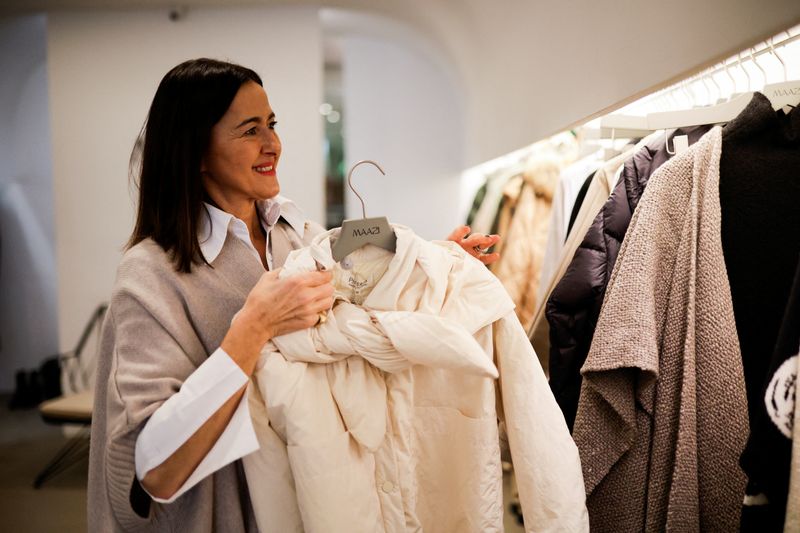By Corina Pons and Virginia Furness
A CORUNA, Spain/LONDON (Reuters) - In Spain's A Coruna, two contrasting fashion business models collide - pitching the growing demands for the clothing industry to become more sustainable against the constant need to drive sales.
This rainy, windswept, city on the rugged Atlantic coast is the unlikely headquarters of Zara-owner Inditex (BME:ITX) - the world's biggest fast fashion retailer.
It also hosts small boutiques offering high quality, durable products that consider themselves an alternative to the fast and affordable fashion propelling Inditex's annual sales of 28 billion euros ($30 billion).
Inditex's massive output of garments was a factor behind the European Union's pledge last year to reverse the "overproduction and overconsumption of clothing". It wants all clothes sold in the bloc to be "long-lived and recyclable" by 2030.
The EU will announce its most significant proposals for the industry yet at the end of March, environment commissioner Virginijus Sinkevičius told Reuters on the sidelines of an event in Portugal last week.
The European Commission wants to ensure companies only manufacture the number of products they need. It will stop short of imposing restrictions, instead asking firms to police themselves to be called sustainable, Sinkevičius said.
"If you release tonnes and tonnes of clothes, textiles, shoes into the market, you will have to collect it," he said.
Around 5.8 million tonnes of textile products are discarded every year in the EU, equivalent to 11 kg (24 lb) per person. A truckload of textile products is landfilled or incinerated somewhere in the world every second, according to EU figures.
Inditex had 565,027 tonnes of garments on the market in 2021, more than the 528,797 tonnes in 2018, according to its annual report. The company may disclose a further increase when its 2022 annual report is published next month.
So far, Inditex shows no sign of slowing production. But it is changing some processes, aiming to reduce its environmental impact while sticking to its strategy of regular new ranges.
Central to that plan is using recycled materials and cutting water, energy and raw material usage, Inditex told Reuters in emailed responses to questions.
"We believe that it is not a question of how much (is manufactured), but of how," the company said.
Half of Inditex's garments were produced in a more sustainable way in 2021 - by for example using organic cotton or fibres that do not pose a risk to endangered forests - compared with 9% in 2018, the company said in its annual report, without giving specific data on how these materials reduce its environmental impact.
Inditex adjusts production to match customer demand and only 2% of stock needs to be recycled or donated, it said in its emailed responses to questions.
The company is targeting net zero emissions by 2040, and its strategy has been approved by the Science Based Targets Initiative (SBTi), a body which scrutinises companies' sustainability policies.
LEAVING LITTLE TRACE
Some of A Coruna's smaller boutiques are run by former Inditex designers or sales staff who left to set up their own operations, emulating Inditex founder Amancio Ortega who established his first Zara store in A Coruna in 1975.
Among them are Jorge Toba, 37, and Antia Montero, 31, who worked at Inditex in purchasing and design. They launched children's clothing brand The Campamento in 2018, producing just two, made-to-order collections a year, mostly with organic fibres.
They don't add new products mid-season and they charge online shoppers for returns to encourage conscientious shopping.
"This is a very polluting industry, so we try to leave as little trace as possible," Montero said at a warehouse in the heart of the city from which the business is run.
'A DROP IN THE OCEAN'
Inditex, itself, is working with more than 100 startups specialising in recycling fibres.
Circ, a U.S. company focusing on textile-to-textile recycling in which Inditex invested last year, is developing new technologies to separate cotton and polyester blended in most clothes, the first step to produce clothing from used or waste textile materials, its president Peter Majeranowski said.
But Circ and its competitors are only capable of producing 1% of the textiles needed to make the 109 million tonnes of clothes per year that the global fashion industry churns out.
"It's really a drop in the ocean," Majeranowski said. The goal is to recycle 10% of annual production by 2030, he said.
Marian Fernandez, 56, spent 25 years at Inditex, rising to become one of the top managers of its luxury brand Uterque before setting up her own fashion shop, Maazi, in downtown A Coruna. She posts weekly videos on social media teaching customers how to build a "responsible" wardrobe with dresses that can be used for multiple occasions and seasons.
Boutique labels in A Coruna could show the way to others.

"It's in new and smaller companies where innovation starts," said Achim Berg, a senior partner at global firm McKinsey & Co.
($1 = 0.9320 euros)